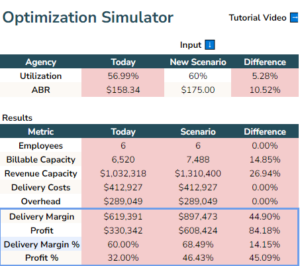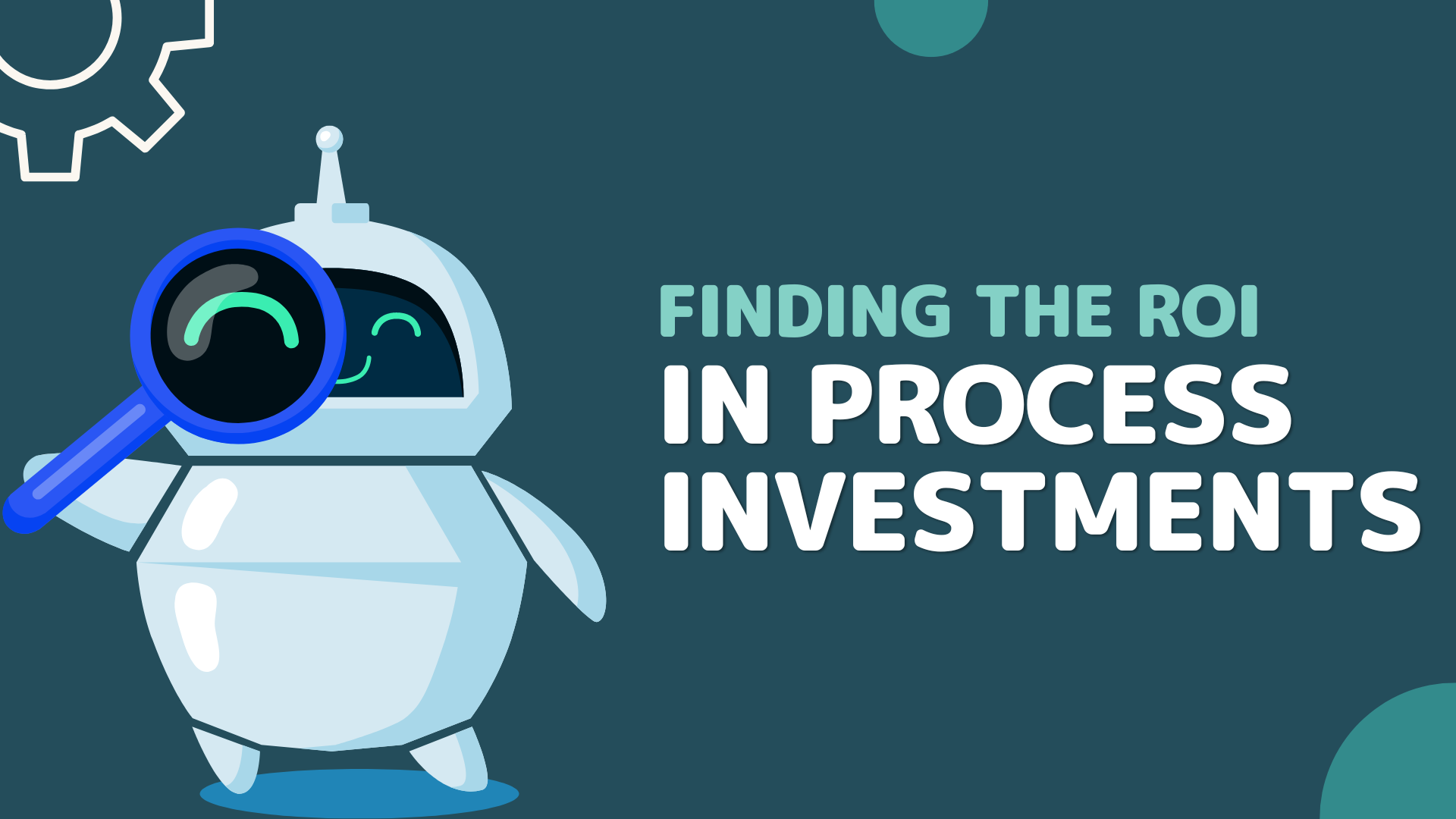The hype around “process” is warranted. I’m making it sound like a fad – it’s not. Processes and procedures for refined workflows are here to stay. Well designed processes are a sign of a mature operations team. But “process” can be hard to invest in, and hard to quantify the ROI when you do so.
That’s because if everything is going well at your agency and you’re growing as anticipated, your processes should be breaking – all of the time. Iteration and pivots as time goes on will render your team’s previous processes obsolete… *flush*.
So how can you know if it’s worth the time and money to invest in your team’s processes?
I’ll take you through some really quick math that you can do yourself to make a decision on that. First, let’s set the foundations.
What is “Process”?
The way that I’ll be using the word process in this post is referring to a procedure that your team follows when completing tasks. This applies to a broad process of how your team will deliver on a service you’ve sold, all the way down to individual tasks in a given phase of the project. Step by step, how to get it done. These are also called Standard Operating Procedures (SOPs) in the corporate world.
Investing in Process
There are two ways you could invest in a process. Either through time, or money. Either you use your team’s time to develop processes, or you pay someone else to develop those processes (which inevitably will also take up your team’s time).
For the purposes of this post, we’re going to assume that you’re not outsourcing the documentation or creation of your processes and procedures to a third party. It’s your team creating these processes, therefore the investment here is “time”.
If you have your team develop your processes, it usually means that as a team member is doing a given task, they’ll retrace their steps and document each part of the process along the way by using a screen share or text document (or both). While it might take them longer to complete the given task since they’re constantly stopping to document it along the way, the thought is that they’ll be able to do it more efficiently the next time. In theory they’d also be able to avoid common errors with checks scattered throughout the process.
Quantifying Process Investment Costs
How much does it actually cost you to invest in a process? This will vary depending on just how sophisticated and detailed you’re getting with your processes and systems, but here is some math you can do on your own to make this happen.
Note: having your team track their time around process creation will be imperative for this kind of calculation to be possible. If you don’t track your time, here is a resource on implementing it properly.
Cost Per Hour
How much does one person’s time cost per hour? You can calculate this using a calculator we’ve already created here, but real quick, the formula we use is:
ACPH = Total Compensation / Gross Capacity
The total compensation figure can be found by summating your team’s annual salary, benefits, payroll tax, and bonuses. Gross capacity is essentially your team members annual working hours (for a typical employee, that would be 40 hours a week for 52 weeks a year) which would be 2080 hours.
For a typical employee:
CPH = $85,000 / 2080
CPH = $40.87
For a team:
| Employee | Total Compensation | Gross Capacity | CPH |
| Team Member 1 | $85,000 | 2080 | $40.9/h |
| Team Member 2 | $71,000 | 2080 | $34.1/h |
| Team Member 3 | $110,000 | 1520 | $72.3/h |
| Team Member 4 | $98,000 | 2080 | $47.1/h |
| Avg = $48.60 |
Adding the Time Variable
We now know the cost of each hour that your team spends. You can keep it high level by taking a blended Average CPH across the team, or using an individual’s CPH for each calculation.
Next is to determine how you currently deploy your team’s time across processes. Either you apply a standard “x hours per week” towards process improvements for everyone, or you track time towards individual processes.
If your agency’s policy is to spend about 2 hours a week on process improvements and iterations, one team member would spend 104 hours on process a year. Let’s see how this adds up.
Calculating your Cost
With a team member spending 2 hours a week on process for a full year, with their ACPH being $40.9/h, your total investment into process yearly is $4,253.60.
Here is what that could look like across the team:
| Employee | Total Comp | Capacity | CPH | Annual Hrs on Process | Total Annual Cost |
| Team Member 1 | $85,000 | 2080 | $40.9/h | 104 | $4,253.60 |
| Team Member 2 | $71,000 | 2080 | $34.1/h | 104 | $3,546.40 |
| Team Member 3 | $110,000 | 1520 | $72.3/h | 104 | $7,519.20 |
| Total = $15,318 |
These numbers are a little scary. But, you likely already knew the cost of process. We aren’t even including here the potential revenue lost by using that hour on process instead of billing it to the client, but that’s a whole other can of worms.
Now that I’ve scared you, we can talk about finding that ROI to make processes make sense to invest in.
Want to model the ACPH for every member of your team, as well as their Utilization, Revenue Capacity and other useful metrics? Get access to Agency Model Generator (and a bunch of other free tools & training videos) inside the Agency Profit Toolkit.

Finding the ROI
There are two prongs to this – efficiency, and delegation.
Efficiency
Delivering your projects more efficiently can have a significant impact on your bottom line (duh!). Imagine this is how a typical project looked at your agency:
Project 1: Website Design & Development, AGI is $5,000.
| Team Member | Role | Hours Spent | CPH | Total Cost |
| Jimmy | Sr. Designer | 22 | $43/h | $946 |
| Jake | Sr. Developer | 20 | $46/h | $920 |
| Jessica | Project Manager | 8 | $39/h | $312 |
| $2178 |
With an AGI of $5,000, this project cost you $2,178 to deliver, leaving you with a Delivery Profit of $2,822 (represents 56% Delivery Margin, slightly below industry standard of 60-70% on a per-project basis).
What could this look like if your team had SOPs to follow, allowing for less time invested in the long run?
Project 1: Website Design & Development, AGI is $5,000.
| Team Member | Role | Hours Spent | CPH | Total Cost |
| Jimmy | Sr. Designer | 18 | $43/h | $774 |
| Jake | Sr. Developer | 17 | $46/h | $782 |
| Jessica | Project Manager | 6 | $39/h | $234 |
| $1,790 |
This moves our Delivery Profit from $2,822 to $3,210 which represents a healthy 64% Delivery Margin. You’re saving $388 per project because of your process investments.
If you invested $15k into process, you’d need to deliver on 39 projects across the year to break even on that investment. But, let’s look at another option, delegation, as an area for opportunity as well.
Did you know?
Delegation
Making process investments worth it can also be done by enabling projects and tasks to be delegated to lower cost employees. By relying more on your junior team for tactical execution, you’ll see better margins while also allowing your team to take on more responsibility, leading them to continue on the growth path they’ve set out for themselves.
Imagine that we’re the same company, but instead of relying on the below team for delivering a project:
Project 1: Website Design & Development, AGI is $5,000.
| Team Member | Role | Hours Spent | CPH | Total Cost |
| Jimmy | Sr. Designer | 22 | $43/h | $946 |
| Jake | Sr. Developer | 20 | $46/h | $920 |
| Jessica | Project Manager | 8 | $39/h | $312 |
| 50 | $2178 |
We restructure that team to have most of the tactical execution be taken on by your junior members (remember, we’re actually using the same amount of hours here):
Project 1: Website Design & Development, AGI is $5,000.
| Team Member | Role | Hours Spent | CPH | Total Cost |
| Jimmy | Sr. Designer | 2 | $43/h | $86 |
| Jake | Sr. Developer | 3 | $46/h | $138 |
| Shawn | Jr. Designer | 20 | $20/h | $400 |
| Ashley | Jr. Developer | 17 | $19/h | $323 |
| Jessica | Project Manager | 8 | $39/h | $312 |
| 50 | $1,259 |
Clearly, by relying more on your processes to guide your junior members through the service delivery, you can notice a significant cost savings. This would allow your senior team members to oversee multiple projects (rather than delivering the work) and open up opportunities for expansion and growth to take on more projects.
This kind of restructure would represent a Delivery Profit of $3,741 relative to the original $2,822. It’s a Delivery Margin improvement from 56% to 74%.
A Combined Effort
It’s less likely that you’re able to have outstanding results in both the efficiency and delegation areas right out of the gate. What’s more likely is that modest efforts at both contribute to a strong ROI on your process investments.
Here is our baseline scenario:
Project 1: Website Design & Development, AGI is $5,000.
| Team Member | Role | Hours Spent | CPH | Total Cost |
| Jimmy | Sr. Designer | 22 | $43/h | $946 |
| Jake | Sr. Developer | 20 | $46/h | $920 |
| Jessica | Project Manager | 8 | $39/h | $312 |
| 50 | $2178 |
And now let’s add in modest improvements in both efficiency to deliver (hours spent) and delegation:
Project 1: Website Design & Development, AGI is $5,000.
| Team Member | Role | Hours Spent | CPH | Total Cost |
| Jimmy | Sr. Designer | 7 | $43/h | $301 |
| Jake | Sr. Developer | 7 | $46/h | $322 |
| Shawn | Jr. Designer | 10 | $25/h | $250 |
| Ashley | Jr. Developer | 10 | $24/h | $240 |
| Jessica | Project Manager | 7 | $39/h | $273 |
| 41 | $1,386 |
With both a modest level of delegation and efficiency, a delivery cost from $2,178 was taken down to $1,386, leaving a Delivery Margin of a very strong 72%.
With these savings coming in at $792 per project, and an annual investment of $15,318 on process, you’d only need to deliver 19 projects to break even on your investment. If you delivered 30 projects, your ROI on process investments would be over $8k.
Did you know?
Parakeeto offers a totally free toolkit where you can automatically generate your Delivery Margin and other profitability metrics using our Optimization Simulator. Here is what that looks like:

Zooming Out
Let’s zoom out for a moment and consider some of the indirect benefits that investments in process can have on your agency.
An agency running on strong processes would see benefits such as:
- Improving the consistency and quality of the work product
- Adherence to timelines
- Which then could lead to more retention or repeat business from clients.
- Reduction of training and onboarding time for new hires
- Improving the cross-functionality of the team which can help reduce dependencies on certain team members, or the impact of vacations, etc.
- All of this should result in better culture, employee retention, etc.
- Clearer processes and documentation should also help management time on projects since there won’t be as much time spent correcting errors, providing context, reviewing work, etc. and reduce the cost and time required to scope and price work as it becomes more predictable.
With all of this added clarity and efficiency, you’re likely to be experiencing much more than an $8k ROI on your process improvements. A better understanding of roles and handoffs will lead to the opening up of more delivery capacity, allowing your team members to take on more client work and generate more revenue (in other words, they’re increasing their utilization rate). Similarly, a decrease in the hours needed to deliver a project is essentially an increase in your Average Billable Rate. These two operational levers present a huge opportunity at the agency level.
In Closing
In closing, the importance of “process” isn’t just a passing trend – it’s a sign of a well-developed operations team. Though measuring the return on investment in process improvements might seem tricky, breaking it down reveals a clear picture. Your team’s effort in crafting precise SOPs is an investment in their skills and operational excellence. This investment costs money, but the benefits in efficiency and delegation are significant. Balancing these benefits takes time, but it leads to a valuable Return on Investment that fuels your agency’s growth. So, as you navigate the path of process improvement, remember: today’s investments shape a more efficient and successful future.






0 Comments